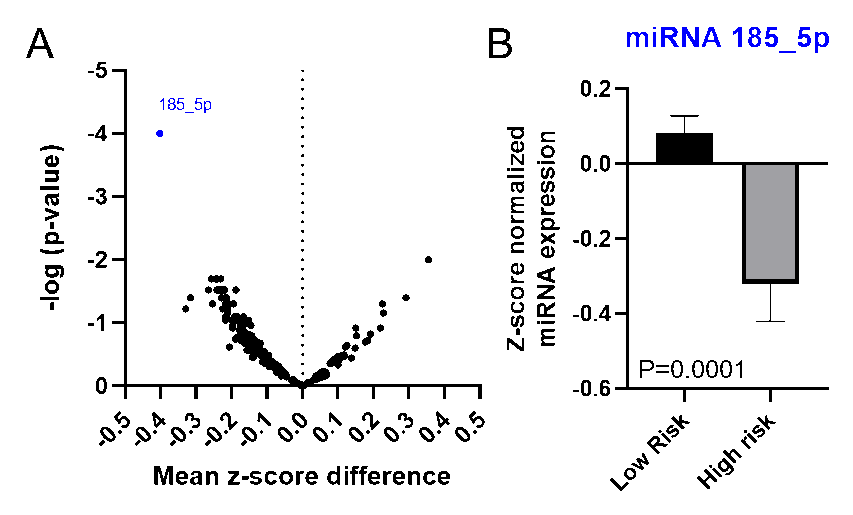Back
Poster, Podium & Video Sessions
Moderated Poster
MP45: Prostate Cancer: Markers
MP45-05: MicroRNA 185-5p is a novel biomarker associated with high-risk pathology at radical prostatectomy in patients with low-risk disease at diagnosis
Sunday, May 15, 2022
1:00 PM – 2:15 PM
Location: Room 225
Kevin Shee*, Cassandra Belair, John Neuhaus, Janet Cowen, Robert Blelloch, Matthew Cooperberg, San Francisco, CA
.jpg)
Kevin Shee, MD, PHD
UCSF
Poster Presenter(s)
Introduction: Predictions of prostate cancer (PCa) outcomes are based on risk stratification tools that use standard parameters including age, PSA levels, biopsy Gleason score (bGS), biopsy tumor extent, and clinical stage, but these often do not fully capture biology that underlies patient outcomes. Non-coding RNAs, particularly microRNAs (miRNAs), have emerged as useful prognostic biomarkers in cancer. The objective of this study was to identify plasma miRNAs to predict post-surgical upgrading and upstaging among patients with low-risk disease at diagnosis.
Methods: Prospectively-collected tissue and plasma samples for prostate cancer patients undergoing prostatectomy were obtained from tissue banks from University of California San Francisco (UCSF) and University of Washington (UW). Patients with initial diagnoses of Gleason score =3+4 and clinical stage =T2, were included for analysis. RNA was isolated from plasma and were assessed for expression of ~2500 miRNAs. miRNAs with >10% missing values were excluded, leaving 239 miRNAs analyzed. Patients were divided into two groups based on pathology at prostatectomy: high-risk, defined as pathologic GS>=4+3 or T>=3a, and low-risk. Marker selection was performed to identify differentially expressed genes, controlling for the false discovery rate (FDR) using the Benjamini and Hochberg method.
Results: 556 patients with an initial diagnosis of low-risk disease were included in analysis. Average age at time of diagnosis was 58 years (SD 7.3). 483 (87%) and 73 (13%) patients had Gleason 3+3 and 3+4 at time of biopsy, respectively. 349 (65%) and 35% of patients had clinical T1 and T2 disease, respectively. 115 (21%) and 441 (79%) of patients were divided into high-risk and low-risk pathologic features after prostatectomy. Using an FDR cutoff of 0.1, miRNA 185-5p was the only significantly differentially regulated miRNA between the two groups (p=0.0001; Figure 1A/B).
Conclusions: In this study, we have identified miRNAs 185_5p as novel miRNA biomarker associated with high-risk pathologic features after prostatectomy in a marker selection analysis. Validation and predictive studies are warranted to determine utility in a clinical setting.
Source of Funding: NIH - 5R01CA198145-05

Methods: Prospectively-collected tissue and plasma samples for prostate cancer patients undergoing prostatectomy were obtained from tissue banks from University of California San Francisco (UCSF) and University of Washington (UW). Patients with initial diagnoses of Gleason score =3+4 and clinical stage =T2, were included for analysis. RNA was isolated from plasma and were assessed for expression of ~2500 miRNAs. miRNAs with >10% missing values were excluded, leaving 239 miRNAs analyzed. Patients were divided into two groups based on pathology at prostatectomy: high-risk, defined as pathologic GS>=4+3 or T>=3a, and low-risk. Marker selection was performed to identify differentially expressed genes, controlling for the false discovery rate (FDR) using the Benjamini and Hochberg method.
Results: 556 patients with an initial diagnosis of low-risk disease were included in analysis. Average age at time of diagnosis was 58 years (SD 7.3). 483 (87%) and 73 (13%) patients had Gleason 3+3 and 3+4 at time of biopsy, respectively. 349 (65%) and 35% of patients had clinical T1 and T2 disease, respectively. 115 (21%) and 441 (79%) of patients were divided into high-risk and low-risk pathologic features after prostatectomy. Using an FDR cutoff of 0.1, miRNA 185-5p was the only significantly differentially regulated miRNA between the two groups (p=0.0001; Figure 1A/B).
Conclusions: In this study, we have identified miRNAs 185_5p as novel miRNA biomarker associated with high-risk pathologic features after prostatectomy in a marker selection analysis. Validation and predictive studies are warranted to determine utility in a clinical setting.
Source of Funding: NIH - 5R01CA198145-05


.jpg)
.jpg)